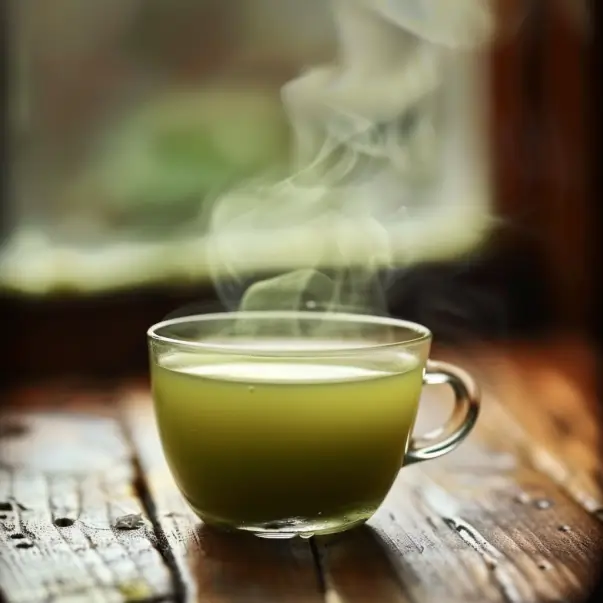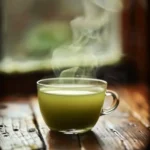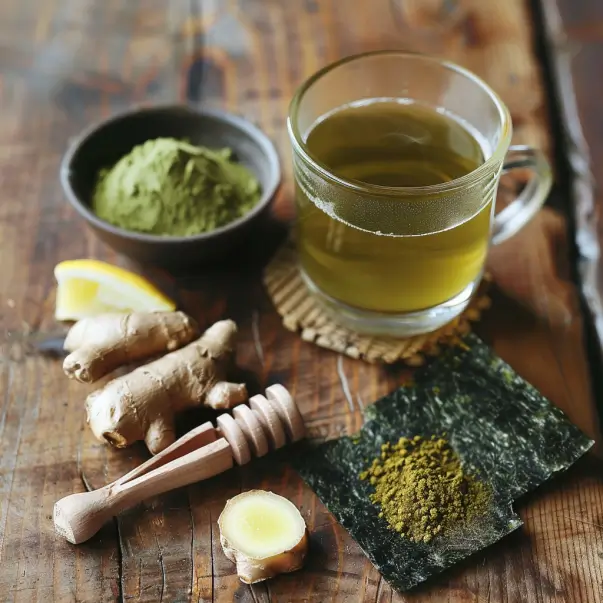Japanese Mounjaro recipe, have you heard of it? I stumbled across this soothing tea during a late-night scroll looking for something natural to help calm my nerves and support my metabolism. You know how it is, too much coffee, not enough sleep, and that endless craving for something comforting that doesn’t derail your health goals. That’s when this calming tea, sometimes called “natural mounjaro tea” or “Japanese fat-burning tonic,” caught my eye. It was simple, honest, and didn’t ask for anything fancy, just four humble ingredients you probably already have.
If you’re serious about wellness drinks, I highly recommend exploring the Pink Salt Trick for weight loss. It’s one of the most talked-about natural methods right now, and it might be just what your routine is missing

My First time making Japanese Mounjaro Tea
The first time I made it, I added too much ginger (big mistake if your stomach’s empty), but once I found the right balance, it quickly became a mid-morning ritual I actually look forward to. What I love about this version of the Japanese mounjaro recipe is how clean it tastes zesty, slightly sweet, with a soft earthy kick from the kombu and matcha. It’s not just another wellness fad it actually feels like something your body says thank you for. If you’re craving something easy, nourishing, and genuinely effective, this calming tea might become your new favorite ritual. Let’s dive in.
Print
Japanese Mounjaro Recipe
- Total Time: 10 minutes
- Yield: 1 Cup
Description
A calming Japanese Mounjaro tea made with matcha, kombu, ginger, and umeboshi. Boosts metabolism, digestion, and focus, naturally.
Ingredients
- 1 tsp matcha powder (ceremonial-grade preferred)
- 1 tbsp umeboshi paste
- 1 tsp fresh ginger (grated)
- 1 strip dried kombu (about 2 inches)
- 1½ cups filtered water
- Optional: 1 tsp lemon juice or raw honey (to taste)
Instructions
- Heat the water in a small saucepan until hot but not boiling. Add the kombu and steep for 5 minutes. Remove the kombu and set aside the infused water.
- In a separate bowl, whisk the matcha powder with 2 tablespoons of warm water until frothy.
- Stir the whisked matcha, grated ginger, and umeboshi paste into the kombu water.
- Add honey or lemon juice if using. Serve warm or over ice.
Notes
- Do not boil the matcha, it ruins the flavor and nutrients.
- Use water around 175°F.
- Umeboshi is salty and tangy, start with less if you’re new to it.
- Great as a hot drink or poured over ice for a refreshing twist.
- Prep Time: 5 minutes
- Cook Time: 5 minutes
- Category: Drinks
- Cuisine: Japanese
Ingredients for the Japanese Mounjaro Recipe
You only need four simple ingredients to create this calming Japanese Mounjaro tea, but don’t be fooled by how minimal it looks. Each component pulls serious weight when it comes to boosting your metabolism and soothing your system. I’ve personally tried variations, but this combo right here? It hits just right, clean, light, and functional.

Here’s exactly what you’ll need:
| Ingredient | Quantity | Purpose |
|---|---|---|
| Matcha Powder (ceremonial-grade) | 1 tsp | Rich in antioxidants & L-theanine for calm energy |
| Umeboshi Paste | 1 tbsp | Adds tangy umami & supports digestion |
| Fresh Ginger (grated) | 1 tsp | Anti-inflammatory & boosts metabolism |
| Dried Kombu Strip | 1 small strip (~2 inches) | Provides iodine, minerals & umami depth |
| Optional: Lemon Juice or Honey | 1 tsp | For added zing or sweetness, to taste |
Tools Needed for Preparation
You don’t need a fancy Japanese tea set to make this work. Just a few basics you probably already have in your kitchen will do the trick. If you’re like me and make this often (guilty!), investing in a matcha whisk or chasen might be worth it; but it’s not a dealbreaker.
| Tool | Why You Need It |
|---|---|
| Small saucepan or kettle | To warm the water gently for the tea |
| Fine grater or microplane | Essential for fresh ginger prep |
| Measuring spoons | Keep your ratios on point, especially the matcha |
| Small whisk or chasen | To get that frothy, smooth matcha texture |
| Mug or glass | Any favorite will do, but a clear glass shows off the color! |
Step-by-Step Guide to Making the Japanese Mounjaro Tea
Alright, it’s go-time. This Japanese Mounjaro recipe isn’t just about throwing stuff into a mug and calling it tea, it’s a mindful process that feels almost meditative. After the first couple of times, it will becomes second nature. Below is the method I personally follow, including the little tweaks I learned the hard way (yes, I once boiled the matcha… big mistake).
Step 1 – Make the Kombu Infusion
- Place your dried kombu strip in a small saucepan with about 1½ cups of water.
- Warm the water gently, don’t let it boil. Keep it just under simmering for 5 minutes.
- Remove the kombu and let the mineral-rich broth cool slightly.
Tip: Kombu is like the unsung hero here, it’s packed with iodine and minerals, and gives the tea this subtle ocean-y depth. Trust me, skip it and the flavor feels flat.
Step 2 – Whisk the Matcha
- In a separate small bowl, add your 1 tsp of matcha powder.
- Splash in roughly two tablespoons of warm water, just make sure it’s not too hot.
- Use a small whisk or chasen to blend it into a smooth, frothy liquid. Go in a quick “W” motion, it’s oddly satisfying.
If the water’s too hot, you’ll ruin the matcha’s L-theanine, which is basically the ingredient that makes you feel chill without the crash. Be gentle!
Step 3 – Mix It All Together
- Add the prepared matcha into your kombu water.
- Stir in 1 tbsp of umeboshi paste and 1 tsp of freshly grated ginger.
- Craving a touch of sweetness or a zesty kick? Go ahead and stir in a drizzle of honey or a squeeze of lemon now.
- Give it one final stir, pour into your favorite mug, and sip slowly.
It’s amazing hot, but if you’re in the middle of a summer heatwave (like I was last week), you can pour it over ice and enjoy a refreshing iced version.
Serving Suggestions for Your Japanese Mounjaro Tea
Now that you’ve got your tea brewed and ready, let’s talk about how to actually enjoy it because believe me, the way you serve this makes a real difference. Think of this as more than just a drink, it’s a daily ritual that can boost your mood, metabolism, and mindset in one warm (or icy) sip.
Best Time to Drink It
- First thing in the morning before breakfast? Ideal. It wakes up your digestion without caffeine jitters.
- Mid-afternoon slump? Yep, this tea is a great alternative to that extra coffee.
- Before or after a light workout? Surprisingly effective for a clean energy boost.
Hot vs. Iced
- Hot: Comforting and grounding, especially when you’re feeling stressed.
- Iced: Super refreshing! Pour it over ice with a lemon wedge.
Serving Style Ideas
- Use a clear glass if you want to show off the green matcha hue.
- Add a lemon slice or mint sprig for a fresh garnish (Instagram-worthy, too).
- Feeling fancy? Serve it in a teacup with a tiny dish of almonds or fruit on the side for a full wellness vibe.
This isn’t just a tea, it’s a moment you’re creating for yourself. So whether you’re sitting at the kitchen counter or enjoying it on your patio, make it count.
If you love Japanese sweets, try serving this tea with chewy dango or a slice of sakura mochi, perfect for a mindful afternoon nibble.
Variations of the Japanese Mounjaro Recipe
Let’s be honest, you’re not going to drink the same version of anything forever. Even with something as wholesome and feel-good as this Japanese Mounjaro recipe, a little variety keeps it exciting. Here are some creative twists I’ve tried (and loved) that still keep things natural, effective, and oh-so-satisfying.
1. The Green Tea Twist
- Swap out the kombu water with freshly brewed green tea.
- Bonus antioxidants and a slightly more familiar taste.
- Works great when you want that extra mental clarity boost.
Nice tip: Sencha or gyokuro tea blends beautifully with matcha.
2. The Citrus-Kick Version
- Add yuzu juice or fresh lemon zest for a zippy, refreshing edge.
- It brightens up the flavor and supports digestion.
- Also helps cut through the bold taste of umeboshi if you’re not used to it yet.
I love this one iced, it tastes like spa water but smarter.
3. Mounjaro Latte Style
- Use warm unsweetened almond milk or oat milk instead of water.
- Blend matcha and ginger first, then top with steamed milk.
- Skip the umeboshi for this one and add cinnamon or nutmeg instead.
It’s not traditional, but when you’re craving something cozy, it hits the spot.
4. No-Sugar, Detox-Boosted
- Skip the honey entirely.
- Add 1 tsp of apple cider vinegar for an extra metabolism and gut support boost.
- Finish with a dash of cayenne pepper if you’re feeling bold (and brave).
Warning: this one’s intense but oddly energizing.
You’re not just limited to these, by the way. Experiment, adjust, and make it yours. That’s the magic of a recipe like this flexible, functional, and full of flavor possibilities.
Common Mistakes and How to Avoid Them
Even though this recipe is super simple, there are a few sneaky ways to mess it up, especially if you’re new to some of the ingredients. Don’t worry though, I’ve done the experimenting (and over-steeping) for you. Here’s how to get it right the first time.
1. Overheating the Water
- Matcha is delicate. Kombu, too. Boiling water destroys the good stuff, like L-theanine and kombu’s mineral profile.
- Use hot but not boiling water (around 175°F or 80°C) for both the matcha and the kombu steep.
2. Using Low-Quality Matcha
- All matcha is not created equal. Ceremonial-grade matcha is what you want, bright green, smooth, and vibrant.
- Culinary-grade works, but it can taste chalky or overly bitter.
3. Skipping the Umeboshi or Kombu
- These two bring in the umami punch and essential minerals. Without them, the tea feels… meh.
- If you’re unsure about umeboshi, start with half a tablespoon and work your way up.
4. Over-Sweetening
- A touch of honey is great. But adding too much defeats the whole purpose of a clean, metabolism-supportive tea.
- Try it unsweetened first, you might be surprised how balanced it is naturally.
Sweet tooth? Use raw honey or a splash of lemon instead, it adds depth without sugar overload.
Nutritional Benefits of the Japanese Mounjaro Recipe
This tea isn’t just calming, it actually supports your body in real ways. Each ingredient brings something useful to the table, and together, they make a solid wellness drink.
- Matcha powder gives you clean energy without the crash. Thanks to L-theanine, it helps you stay focused and calm at the same time.
- Ginger helps with digestion, inflammation, and gives the tea a nice kick. It also warms your system naturally.
- Kombu is rich in iodine and minerals that support thyroid health. It adds a subtle umami depth that makes the tea feel grounding.
- Umeboshi paste is great for gut health and adds a salty, tangy flavor. It’s unique but worth it.
- Lemon juice (if you use it) adds a dose of vitamin C and helps balance the flavor.
Nothing fancy, just clean ingredients doing what they’re supposed to. It’s light, functional, and a great way to support your body without loading up on junk.
| Ingredient | Key Nutrients | Primary Benefit |
|---|---|---|
| Matcha Powder | L-theanine, EGCG, chlorophyll | Boosts focus, metabolism & detox |
| Umeboshi Paste | Citric acid, potassium, antioxidants | Supports liver function & digestion |
| Fresh Ginger | Gingerol, B6, magnesium | Reduces inflammation & bloating |
| Dried Kombu | Iodine, calcium, iron | Supports thyroid health & mineral intake |
| Optional: Lemon Juice | Vitamin C, antioxidants | Aids detox & enhances iron absorption |
What to Pair with Your Japanese Mounjaro Tea
This tea works great on its own, but pairing it with something light makes it even better.
In the morning: Try it with a slice of toast and almond butter, or a boiled egg if you want something savory.
Midday: A handful of almonds, rice crackers, or sliced cucumber with lemon keeps things light but satisfying.
No food? No problem. Sip it during a quiet moment, reading, journaling, or just taking a break. It’s perfect for slowing down.
Keep it simple. This tea isn’t just about health, it’s about feeling good.
Next: let’s see what this recipe actually costs to make. You’ll be surprised how affordable it is.
How Much Does This Recipe Cost?
| Ingredient | Estimated Cost per Use |
|---|---|
| Matcha Powder (1 tsp) | $0.50 |
| Umeboshi Paste (1 tbsp) | $0.30 |
| Fresh Ginger (1 tsp grated) | $0.10 |
| Kombu Strip (~2 inches) | $0.15 |
| Optional: Lemon or Honey | $0.10 |
Total Estimated Cost per Cup: $1.15 to $1.30
Your New Favorite Ritual Starts with This Cup
There you have it your very own Japanese Mounjaro recipe in three easy, calming steps. It’s more than just tea. Whether you’re looking to boost your metabolism, ease digestion, or just take a quiet moment for yourself, this drink checks all the boxes.
You don’t need to be a wellness expert to enjoy this. Just a few simple ingredients, a bit of intention, and boom your body (and probably your mood) will thank you. I’ve made this part of my daily routine, and honestly, I don’t miss the crash from coffee or sugary “energy” drinks one bit.
So ready to make it your own? Brew it, tweak it, and sip it slow. And hey, if you try a variation you love, share it in the comments! I’d love to hear how you make this tea yours.
Give it a try and let me know how it turns out, I’m rooting for your calm, energized self.
Curious for something sweet? Check out our round‑up of easy Japanese dessert recipes, they’ve been getting rave reviews!
Frequently Asked Questions About the Japanese Mounjaro Recipe
It’s a tea made with matcha, ginger, kombu, and umeboshi paste, each ingredient supports metabolism, digestion, and calm energy.
Yes! It’s made with natural ingredients and safe for daily use, just don’t go overboard with the ginger if you’re sensitive.
It can support weight loss goals by boosting metabolism and curbing appetite when paired with healthy habits.
Absolutely. Just brew it as usual and pour over ice; add lemon or mint for a refreshing twist.
Most Asian grocery stores carry them, or you can easily order online, look for high-quality brands with minimal additives.
Tried this Japanese Mounjaro recipe or added your own twist? I’d love to see it! Share your version, drop a comment, or join the fun over on our First Step Recipes Facebook page we’re always cooking up something new and tasty.






